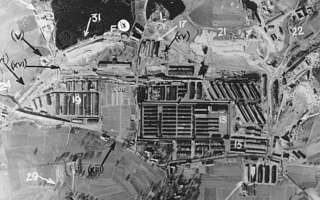The Former Camp Complex
The former camp complex consisted of the three different concentration camps

The history of this complex dates back to a period shortly after the Anschluss of Austria to the German Reich in 1938, when the related Camp Mauthausen was not even founded.
Recent research shows that Camp Gusen I and Camp Mauhausen were planned from the first hour in spring 1938 as a bifurcated system of two more or less equally sized concentration camps. Although conctruction on the Mauthausen part started nearly one year earlier, the main industrial focus of the SS was on the Gusen part from the beginning. Thus the Gusen complex became much more bigger than it's Mauthausen twin, having up to double the number of inmates than Mauthausen in certain periods.
In 1940, the SS supplemented also an administrational headquarter of the SS-owned German Earth and Stone Works (DEST) for the two concentration camps at Gusen and Mauthausen at nearby St. Georgen/Gusen.
In contrast to Mauthausen, Camp Gusen got also a direct railway connection to the Reich via St. Georgen. Also a harbor was planned at Gusen by the SS in 1942, but the project was not carried on because of personal objections by Reich minister Albert Speer.
With 1943, the SS turned the Gusen complex into a huge industrial park that served companies like Steyr-Daimler-Puch AG or Messerschmitt GmbH.
Finally, huge sums were invested by the Reich at the Gusen complex to build two big underground plants at St. Georgen (Bergkristall) and Gusen (Kellerbau).
Camp Gusen I was widely independent from Mauthausen for many years. Only in early 1944 the seperate inmate numbering system of Gusen was merged with that of Mauthausen.
Today we speak about concentration camp complex St. Georgen-Gusen-Mauthausen instead of Gusen as a satellite of Mauthausen. Furthermore, we don´t speak about one camp of Gusen. We speak about three different inmate camps and more than 50 prisoner work commands that were scattered in the period between 1939 and 1945 over an area of several square kilometers in four different rural communities of the region.
#RememberGusen